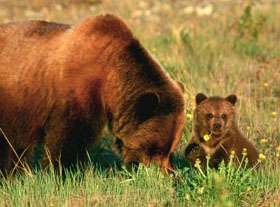A change of heart keeps bears healthy while hibernating

Hibernating, it turns out, is much more complicated than one might think.
Research published in the latest issue of the journal Physiological and Biochemical Zoology illustrates a complex series of changes that occur in grizzly bears' hearts as they hibernate. The changes guard against complications that could arise from greatly reduced activity.
A grizzly hibernates five to six months of the year. During that time, its heart rate slows drastically from around 84 beats per minute when active to around 19. "If a human heart were to slow down like this, you'd see very detrimental things happening," said Bryan Rourke, a professor at Cal State Long Beach who worked on the research with his graduate student, Nathan Barrows.
Such a slow beat causes blood to pool in the heart's four chambers. In a human, the increased pressure would cause the chambers to stretch out. The dilated muscle would be weaker and less efficient, leading ultimately to congestive heart failure.
"Bears are able to avoid this," Rourke said, "and we're interested in how they do it."
Barrows and Rourke worked with Lynne Nelson and Charles Robbins, researchers at Washington State University who have been studying bears for years. They operate a facility at Washington State where grizzlies have been raised since birth and acclimated to echocardiogram testing. Research at the facility is providing crucial insight into the mysteries of the hibernating heart.
Nelson and Robbins had previously shown that, during hibernation, the muscle of a bear's left ventricle stiffens to prevent it from stretching as blood accumulates. But the stiffening of the ventricle presents another problem. The left atrium, which pushes blood into the left ventricle, must then work against greater resistance.
"The atrium is pushing against a brick wall," Rourke said. "We thought there must be some kind of mechanism to keep the atrial muscle from wearing itself out."
Using echocardiogram data from the captive bears at Washington State and tissue samples from wild bears, the researchers found that the atrium protects itself by weakening its beat.
Muscle contractions in the heart are controlled by a protein called myosin heavy chain. The protein comes in two varieties, alpha and beta. The alpha version produces a quicker but slightly weaker contraction compared to the beta. "We found that the muscle in the left atrium produces more alpha protein during hibernation, which results in a slightly weaker beat," Rourke said. "The lower force keeps the atrium from being damaged as it pushes against the stiffer ventricle."
When the bears emerge from hibernation, the protein ratio switches back and the atrial contraction returns to its original strength.
The researchers believe this is the first study to show a shift in myosin ratio in bears, and they hope the information might someday have an application for humans.
"Bears aren't a perfect model for humans, but the way in which a bear's heart can change could be helpful in understanding human disease," Rourke said. "It's a really interesting physiology."
More information: N. D. Barrows, O. L. Nelson, C. T. Robbins, and B. C. Rourke, "Increased Cardiac Alpha-Myosin Heavy Chain in Left Atria and Decreased Myocardial Insulin-Like Growth Factor (IGF-I) Expression Accompany Low Heart Rate in Hibernating Grizzly Bears." Physiological and Biochemical Zoology 84:1 (January/February 2011).
Provided by University of Chicago


















